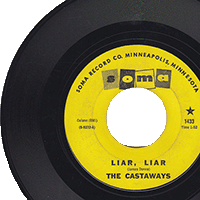Sources
Much of the research I have done would not be possible without the incredible help of the Pavek Museum of Broadcasting, which by sheer coincidence is where my husband, Steve Raymer, was the Managing Director for almost 30 years. The Pavek has provided me with contact information for so many broadcasters, access to photos, and much more personal assistance than I can recount. Because of those contacts I’ve been able to interview many key people in the Twin Cities broadcast community; sadly, many of them have since passed away.
As importantly, Timothy D. Kehr gave me so much help, support, contacts, and encouragement over the years. He didn’t know me from Adam but was so incredibly generous with his time and knowledge. It still feels strange that I can’t pick up the phone and call him with a question.
Much of the information and ads regarding events came from publications such as Connie’s Insider, Music Scene, and similar magazines (see Publications). These publications came from a variety of sources: Issues of the Insider given to me by Mike Barich; Original issues of Music Scene given to me by Rod and Pat Eaton; Issues of the Insider and TMC Insider loaned for copying by Timothy D. Kehr; Issues of Music Scene loaned to me for copying by Dennis Libby; Issues of the Insider loaned to me for copying by Tom Campbell; Microfilm and hard copies of the Insider at the Minnesota Historical Society. I thank each of these contributors so much for their help. Without them I couldn’t do my work.
Pam Albinson, Queen of the Lakes of 1962, was the Keeper of the Flame of the Aquatennial, in conjunction with the Hennepin History Museum. In addition to the information I found in her book, Seventy-Five Years of the Minneapolis Aquatennial, she sent me a list of national entertainers who came to town for the summer festival. For fun I posted all of them, not just musical acts. How fun to know that David Cassidy was Grand Marshall of the 1972 Grande Day Parade!
A big Thanks to Mark Karnowski, who sent a list of State Fair Grandstand shows. All State Fair information is now on a separate page.
The list of Met Center shows comes from Lou Nanne’s book on the history of the Northstars.
Guthrie shows were generously sent to me by James D. Scott, General Manager of the Guthrie.
My friend Ellen Lewis made the great suggestion that I read through back issues of the Minneapolis Spokesman, the newspaper of the city’s African-American community since 1934. I found some phenomenal rhythm & blues shows, mostly taking place at the Labor Temple.
Will Jones’ column in the Minneapolis Tribune was usually very entertaining and had great info and background. Jones retired in 1984 and died in 2004 at the age of 80.
Interviews with some of the old DJs and radio people brought some fascinating stories about how things came to pass. I was able to interview Herb Oscar Anderson, Dick Driscoll, Bill Diehl, Sam Sherwood, John Evans, Bill Armstrong, Vic Tedesco, and others.
The Minnesota Daily had most of their issues on line. I started looking through them in 1952 but didn’t get very far.
For a teen perspective there are references to the St. Louis Park High School Echo newspaper.
My buddy Wayne Klayman just happened to have a stack of ads for concerts from 1969 to 1972, saving me a ton of time, effort, and quarters!
Facebook has been an ENORMOUS source of photos and information. I gave up asking for permission to quote people, so I’ve just put quotes around their comments without their names. If you see your quote and would allow me to use your name, please let me know.
STEBBINS
In May 1964 U of M graduate student Robert A. Stebbins completed his Ph.D. thesis, The Jazz Community: The Sociology of a Musical Sub-Culture. This was a huge find!
- Chapter 4 is a history of jazz in Minneapolis, the first compiled from the music form’s inception until the late 1930s. Stebbins noted that contemporary histories of jazz have bypassed the Twin Cities.
- He also provided an incredibly detailed list and description of the various jazz venues – using sources such as telephone books, he researched when various venues existed, and in many cases noted house bands for particular venues. This information is documented in the Venues section.
- The paper also contains detailed information on performers who came through town, dates, etc. This information is reflected in the Events section.
Much of the information on jazz venues comes from Joined at the Hip: A History of Jazz in the Twin Cities by Jay Goetting, MHS Press (2011). A must read.
The Minnesota Historical Society has a weird array of newspapers on microfilm, which are much fun to look through for venues gone by..
The Hennepin County Central Library has put their permit and inspection cards online. This is a tremendously valuable resource when it comes to researching the history of a building in Hennepin County.
In 1984 Richard Raichelson put out an album called “Twin Cities Shuffle – 1927 To 1930,” with some amazing early local recordings, many made at the Lowry Hotel in St. Paul. Mr. Raichelson was graciously allowed me to quote from the album notes.
For a rural perspective, the Hennepin County Enterprise, highlighting events in and around Hopkins, was consulted for entertainment in the hinterlands in the teens and 1920s.
Tom Prin loaned me his memorabilia, and one of the articles came from the magazine Select. That led to many hours of looking through this guide to Twin Cities nightlife, and I’m not done yet!
Paige Wingert, the granddaughter of jazz drummer Bob Benham, also loaned me her family photos, etc., and there were some bombshells in there, including the story of the first integrated band in downtown Minneapolis. I haven’t entered it yet but I’ll put a link to it when I do. The article was in a newsletter called The St. Paul Musician, and I spent hours at the Minnesota Historical Society racking up lots of St. Paul venues.
Most recently, the Strib has made the Minneapolis Journal, Star, Tribune, Star Tribune, and other early papers available online in a searchable format – no more treks to St. Paul wading through miles of microfilm!
The City of Minneapolis obtained a grant to identify the sites within the city that had been used for music and music halls. These sites are identified in this website as “Minneapolis Report.”
In 1928, Edgar Rudolph wrote a paper called “Early Minneapolis Theaters” for the Minnesota Historical Society Magazine. In it, he included all of the theaters that had existed that he had known of since the founding of the City. Information from this source I will cite as “Edgar.”


